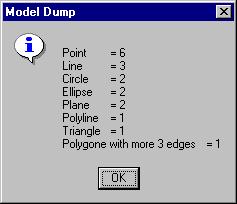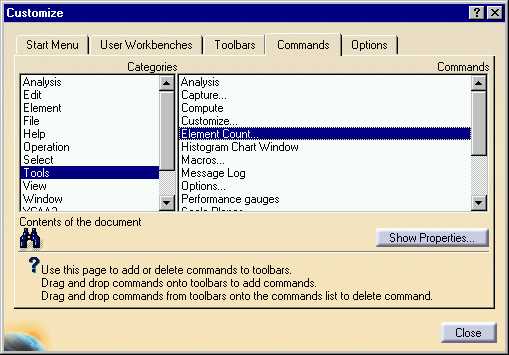
3D PLM Enterprise Architecture |
User Interface - Frame |
Creating Customized Command HeadersExposing your commands and managing their availability |
| Use Case | ||
AbstractThis article shows how to create a customized command header class to expose a command and manage its availability. |
This use case is intended to show how to create a customized command header class to expose a command and manage its availability.
[Top]
CAAAfrDumpCommandHeader is a use case of the CAAApplicationFrame.edu framework that illustrates the ApplicationFrame framework capabilities.
[Top]
 |
The CAAAfrDumpCommandHeader use case creates command header class to manage the availability of the Element Count command. Element Count scans the active CAAGeometry document and prints in a dialog box a bill of the objects contained in the document. This makes sense only if the document is not empty, otherwise the command is made unavailable. The Element Count command availability is managed by its command header. |
The CAAAfrDumpCommandHeader customized command header class plays the following roles:
MacDeclareHeader
macro. This is possible by deriving the command header class from CATCommandHeaderBecomeAvailable and BecomeUnavailable methods
of CATCommandHeader.[Top]
See the section entitled "How to Launch the CAAGeometry Use Case" in the "The CAAGeometry Sample" use case for a detailed description of how this use case should be launched. For the specific scenario :
Do not type the module name on the command line, but type CNEXT instead. When the application is ready, do the following:
[Top]
The CAAAfrDumpCommandHeader use case is made of a single class named CAAAfrDumpCommandHeader located in the CAAAfrGeometryWshop.m module of the CAAApplicationFrame.edu framework:
| Windows | InstallRootDirectory\CAAApplicationFrame.edu\CAAAfrGeometryWshop.m\ |
| Unix | InstallRootDirectory/CAAApplicationFrame.edu/CAAAfrGeometryWshop.m/ |
where InstallRootDirectory is the directory where the CAA CD-ROM
is installed.
CAAAfrDumpCommandHeader is part of the CAA Geometry Creation workshop where it is instantiated.
[Top]
To create the command header for the Element Count command of the CAAAfrGeometryWshop workshop, there are six steps:
| # | Step | Where |
|---|---|---|
| 1 | Create the command header class header file | LocalInterfaces |
| 2 | Declare the command header class resources | CAAAfrDumpCommandHeader.cpp |
| 3 | Set the callbacks to appropriate events and initialize the command availability | Constructor |
| 4 | Create the copy constructor, the Clone method, and the destructor | CAAAfrDumpCommandHeader.cpp |
| 5 | Create the callback methods that manage the command availability | CAAAfrDumpCommandHeader.cpp |
| 6 | Instantiate the command header class | CAAAfrGeometryWshop.m CreateCommands method |
| 7 | Assign resources to the command header instance | Resource files |
[Top]
The CAAAfrDumpCommandHeader header file is as follows:
#include <CATCommandHeader.h>
...
class CAAAfrDumpCommandHeader : public CATCommandHeader
{
CATDeclareClass;
CATDeclareHeaderResources;
public:
CAAAfrDumpCommandHeader(const CATString & iHeaderName);
virtual ~CAAAfrDumpCommandHeader();
CATCommandHeader * Clone();
private:
CAAAfrDumpCommandHeader(CATCommandHeader *iHeaderToCopy);
CAAAfrDumpCommandHeader(const CAAAfrDumpCommandHeader &iObjectToCopy);
void AnalyzeFilledCB(CATCallbackEvent iPublishedEvent,
void * ipPublishingObject,
CATNotification * ipPublishNotification,
CATSubscriberData iUsefulData,
CATCallback iCallbackId);
void AnalyzeEmptyCB (CATCallbackEvent iPublishedEvent,
void * ipPublishingObject,
CATNotification * ipPublishNotification,
CATSubscriberData iUsefulData,
CATCallback iCallbackId);
private:
CAAISysCollection * _pCollection;
};
|
CAAAfrDumpCommandHeader derives from CATCommandHeader. The CATDeclareClass
macro declares that it belongs to a CAA component. The CATDeclareHeaderResources
macro inserts the methods to manage the command header resources.
About the mandatory public methods:
constructor with a reference to a const
CATStringdestructor,
Clone method inherited from CATCommandHeader and
used to duplicate the command header instance. Refer to the "Customized
Command Header Class Structure" section of the technical article about
the command headers [2]. You will have all the
details about the Clone method. About the mandatory private methods:
constructor taking a pointer to a CATCommandHeader
is dedicated to the Clone method.
constructor are declared in the private part, and
are not implemented in the source file. This prevents the compiler from
creating them as public without you know. Two callback
methods, AnalyzeFilledCB and AnalyzeEmptyCB, are
declared to be called when the document contains objects or when it is empty
respectively. _pCollection is a pointer to the collection of
objects in the document, and is document dependent.
[Top]
The CAAAfrDumpCommandHeader source file contains the resource declaration:
...
CATImplementClass(CAAAfrDumpCommandHeader,Implementation, CATCommandHeader, CATNull);
CATImplementHeaderResources(CAAAfrDumpCommandHeader,
CATCommandHeader,
CAAAfrDumpCommandHeader);
...
|
A customized command header is a CAA component. The CATImplementClass
macro makes the class CAAAfrDumpCommandHeader a component main class (Implementation)
that OM-derives [1] from CATCommandHeader. The CATImplementHeaderResources
macro is used in conjunction with the CATDeclareHeaderResources
macro in the header file. It states that the CAAAfrDumpCommandHeader
class derives from CATCommandHeader, and that its associated resource
file names use the class name: CAAAfrDumpCommandHeader.CATNls and
CAAAfrDumpCommandHeader.CATRsc respectively. The base class name set as second
argument helps to use resource concatenation. The third argument could be set to
the name of another class that is associated with resource files that use its
class name, or to the name, without suffix, of an already existing resource file
pair.
[Top]
This is done in the CAAAfrDumpCommandHeader as follows:
...
CAAAfrDumpCommandHeader::CAAAfrDumpCommandHeader(const CATString &iHeaderName)
: CATCommandHeader(iHeaderName, // Command header id
"CAAAfrGeoCommands", // Command shared lib or DLL
"CAAAfrDumpCmd", // Command class
(void*) NULL), // No parameter to pass to the command
_pCollection(NULL)
{
... // Get _pCollection
if (NULL != _pCollection)
::AddCallback(this,
_pCollection,
"CAASysCollectionEmptyNotif",
(CATSubscriberMethod)&CAAAfrDumpCommandHeader::AnalyzeEmptyCB,
NULL);
::AddCallback(this,
_pCollection,
"CAASysCollectionFilledNotif",
(CATSubscriberMethod)&CAAAfrDumpCommandHeader::AnalyzeFilledCB,
NULL);
int nbobject = 0;
_pCollection->GetNumberOfObjects(&nbobject);
if ( nbobject > 1 )
BecomeAvailable();
else
BecomeUnavailable();
}
else
BecomeUnavailable();
}
CAAAfrDumpCommandHeader::~CAAAfrDumpCommandHeader()
{
if ( NULL != _pCollection)
{
RemoveSubscriberCallbacks(_pCollection);
_pCollection->Release();
_pCollection = NULL ;
}
...
|
The constructor first retrieves a pointer to a collection interface that
manages the objects in the document. This is document implementation dependent.
When the document is created or becomes empty, the collection sends a CAASysCollectionEmptyNotif
notification class instance. On the opposite, when the first object is created
in the document, the collection sends a CAASysCollectionFilledNotif
notification class instance. A callback is set for each of these notifications
thanks to the AddCallback global function, whose parameters are
(for the first function call):
this |
The object that executes the callback method |
_pCollection |
The object that sends the notification |
CAASysCollectionEmptyNotif |
The class name of the notification sent |
AnalyzeEmptyCB |
The method to call back |
NULL |
Possible useful data to pass to the method |
The constructor finally asks the collection interface pointer to know whether
the document is empty (An empty document contains at least one object: the
UIactive object.) Depending on the answer, it initializes the command
availability using the two methods BecomeAvailable and BecomeUnavailable.
This is valid only at the command header class instantiation, and the callbacks
will change this availability afterwards if needed.
Don't forget to remove the subscriptions in the destructor using the RemoveSubscriberCallbacks
method.
[Top]
This is done in the CAAAfrDumpCommandHeader as follows:
...
CAAAfrDumpCommandHeader::CAAAfrDumpCommandHeader(CATCommandHeader * iHeaderToCopy)
: CATCommandHeader(iHeaderToCopy),
_pCollection(NULL)
{}
CATCommandHeader * CAAAfrDumpCommandHeader::Clone()
{
return new CAAAfrDumpCommandHeader(this);
}
CAAAfrDumpCommandHeader::~CAAAfrDumpCommandHeader()
{
if ( NULL != _pCollection)
{
RemoveSubscriberCallbacks(_pCollection);
_pCollection->Release();
_pCollection = NULL;
}
...
|
The Clone method uses the copy constructor.
Don't forget to remove the subscriptions in the destructor using the RemoveSubscriberCallbacks
method.
[Top]
This is done in the CAAAfrDumpCommandHeader as follows:
...
void CAAAfrDumpCommandHeader::AnalyzeFilledCB(CATCallbackEvent iPublishedEvent,
void * ipPublishingObject,
CATNotification * ipNotif,
CATSubscriberData iUsefulData,
CATCallback iCallbackId)
{
BecomeAvailable();
}
void CAAAfrDumpCommandHeader::AnalyzeEmptyCB (CATCallbackEvent iPublishedEvent,
void * ipPublishingObject,
CATNotification * ipNotif,
CATSubscriberData iUsefulData,
CATCallback iCallbackId)
{
BecomeUnavailable();
}
|
These two methods have the classical signatures of callback methods. Depending on the notification sent, they simply set the command availability accordingly.
[Top]
To instantiate this command header, the CreateCommands method of
the CAAAfrGeometryWks workshop class should call its constructor with the
command header identifier as parameter.
void CAAAfrGeometryWks::CreateCommands()
{
...
new CAAAfrDumpCommandHeader("CAAAfrDumpHdr");
...
|
where CAAAfrDumpHdr is the identifier assigned to the command
header. It will be used afterwards to associate the command starters defined to
put the command in a menu and in toolbars with the command header. This
identifier is also used to build the variables that define the command header
resources, such as the name seen by the end user in his/her own language in the
menu, or the icon to display in a toolbar.
[Top]
The CAAAfrDumpCommandHeader class is automatically associated with two resources files whose names are built using the class name:
The resources are designated using a key built as a concatenation of the command header class name, the command header instance identifier, and the resource keyword, separated by dots. The CAAAfrDumpCommandHeader.CATNls file includes the following for the Point command:
CAAAfrDumpCommandHeader.CAAAfrDumpHdr.Title = "Element Count..."; CAAAfrDumpCommandHeader.CAAAfrDumpHdr.ShortHelp = "Element Count"; CAAAfrDumpCommandHeader.CAAAfrDumpHdr.Help = "Contents of the document"; CAAAfrDumpCommandHeader.CAAAfrDumpHdr.LongHelp = "Element Count (Tools menu) This command enables the user to dump document contents"; CAAAfrDumpCommandHeader.CAAAfrDumpHdr.Category = "Tools"; |
These resources are:
| Title | Text displayed in the Tools menu for the command | |
| ShortHelp |  |
Text displayed in a balloon as the command short help message when the mouse moves over the command when this command is in a toolbar. This is not applicable to commands located in the menu bar |
| Help | Text displayed in the status bar as the command help message when the mouse moves over the command. This is not applicable to commands located only in the menu bar, but is applicable for commands located in both the menu bar and a toolbar | |
| LongHelp | Text displayed in a balloon when the end user clicks |
|
| Category |  |
An attribute associated with the command and used to sort the commands in the Commands tab page of the Customize window |
The CAAAfrGeometryWksHeader.CATRsc file includes the following for the Point command:
CAAAfrDumpCommandHeader.CAAAfrDumpHdr.Icon.Normal = "I_CAAFindP2"; CAAAfrDumpCommandHeader.CAAAfrDumpHdr.LongHelpId = "CAAAfrDumpCommandHeader.CAAAfrDumpHdr"; |
These are the file names of the icons used to show the Element Count command in the toolbar:
| Icon.Normal | Icon associated with the command and used in toolbars when the command is available. The greyed icon associated with the command when it is unavailable is computed from this one. In a P2 session, the shadowed icon displayed for default state and the Pressed and Focused icons are computed from the Normal one too. | |
| LongHelpId | Identifier associated with the command and that calls the command help when the F1 key is pressed while the command is active |
[Top]
A command header stands for a command and avoids to load the command when the
end user does not require it. A command header is an instance of a command
header class. A customized command header created by deriving the CATCommandHeader
class can manage the command availability with respect to the document contents
or to any other criterion using the BecomeAvailable and BecomeUnavailable
methods.
[Top]
| [1] | Object Modeler Component and Implementation Inheritances |
| [2] | The Command Headers |
| [Top] | |
| Version: 1 [Jan 2000] | Document created |
| Version: 2 [Feb 2004] | Document updated |
| [Top] | |
Copyright © 2000, Dassault Systèmes. All rights reserved.